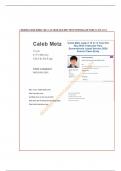PART 1 MEDICAL-SURGICAL CASES CASE STUDY 11
Case Study 11 Hypovolemia
Difficulty: Advanced
Setting: Hospital emergency department, medical intensive care unit
Index Words: hypovolemia, hypertension, idiopathic dilated cardiomyopathy, peptic ulcer disease, assessment, laboratory values, fluid
balance, hyperkalemia, electrocardiogram (ECG) strip Giddens Concepts: Care Coordination, Fluid and Electrolyte Balance, Perfusion HE
Concepts: Assessment, Care Coordination, Fluid & Electrolyte, Perfusion
Scenario
The wife of C.W., a 70-year-old man, brought him to the emergency department (ED) at 0430. She told the
ED triage nurse that he had had diarrhea for the past 3 days and that last night he had a lot of “dark red”
diarrhea. When he became very dizzy, disoriented, and weak this morning, she decided to bring him to the
hospital. C.W.'s vital signs (VS) in the ED were 70/− (systolic blood pressure [SBP] 70 mm Hg, diastolic blood
pressure [DBP inaudible), pulse rate 110 beats/min, 22 breaths/min, oral temperature 99.1 ° F (37.3 ° C). A
16-gauge IV catheter was inserted and a lactated Ringer's (LR) infusion was started. The triage nurse
obtained the following history from the patient and his wife. C.W. has had idiopathic dilated cardiomyopathy
for several years. The onset was insidious, but the cardiomyopathy is now severe, as evidenced by an
ejection fraction of 13% found during a recent cardiac catheterization. He experiences frequent problems
with heart failure (HF) because of the cardiomyopathy. Two years ago, he had a cardiac arrest that was
attributed to hypokalemia. He has a long history of hypertension and arthritis. He had atrial fibrillation in
the past but it has been under control recently. Fifteen years ago he had a peptic ulcer.
howed a 25- × 15-mm duodenal ulcer with adherent clot. The ulcer was cauterized and C.W. was
admitted to the medical intensive care unit (MICU) for treatment of his volume deficit. You are his admitting
nurse. As you are making him comfortable, Mrs. W. gives you a paper sack filled with the bottles of
medications he has been taking: enalapril (Vasotec) 5 mg PO bid, warfarin (Coumadin) 5 mg/day PO, digoxin
(Lanoxin) 0.125 mg/day PO, potassium chloride 20 mEq PO bid, and diclofenac (Voltaren) 50 mg PO tid. As
you connect him to the cardiac monitor, you note he is in sinus tachycardia. Doing a quick assessment, you
find a pale man who is sleepy but arousable and slightly disoriented. He states he is still dizzy. His BP is 98/52,
pulse is 118, and respiratory rate 26. You hear S3 and S4 heart sounds and a grade II/ VI systolic murmur.
Peripheral pulses are all 2+, and trace pedal edema is present. Lungs are clear. Bowel sounds are present,
midepigastric tenderness is noted, and the liver margin is 4 cm below the costal margin. A Swan-Ganz
pulmonary artery catheter and a peripheral arterial line are inserted.
1. What may have precipitated C.W.'s gastrointestinal (GI) bleeding?
25- × 15-mm duodenal ulcer with adherent clot
, 51
PART 1 MEDICAL-SURGICAL CASES
2. From his history and assessment, identify five signs and symptoms (S/S) of GI bleeding
and loss of blood volume.
Dark red diarrhea Diarrhea for the past 3 days (loss of volume)
Dizzy, disoriented, and weak (loss of volume)
70/- (DBP inaudible) (loss of volume)
Increase HR (compensation secondary to Hypovulimea) (Pt with elevated temp.)
3. What is the most serious potential complication of C.W.'s bleeding? Hypoperfusion
secondary to hypovolemia, risk for hypovolemic shock
4.
Calculate C.W's mean arterial pressure (MAP) and explain why this measure is important.
MAP = 1/3 * SBP + 2/3 * DBP
MAP = 1/3 * 98 + 2/3 * 52
MAP = 32.7 + 34.7
MAP = 67
MAP is a good indicator of perfusion. The normal MAP range is between 70 and 100 mmHg.
A MAP of at least 60 mmHg is needed to provide enough blood to the coronary arteries, kidneys, and br
CASE STUDY PROGRESS
As soon as you get a chance, you review C.W.'s admission laboratory results.
Laboratory Results
Sodium 138 mEq/L
Potassium 6.9 mEq/L
BUN 90 mg/dL
Creatinine 2.1 mg/dL
WBC 16,000/mm3
Hgb 8.4 g/dL
Hct 25%
PT 23.4 seconds
INR 4.8
5. After examination of the lab results, are there any concerns with C.W.'s electrolyte levels?
Explain your answer.
BUN, creatinine, Potassium,




